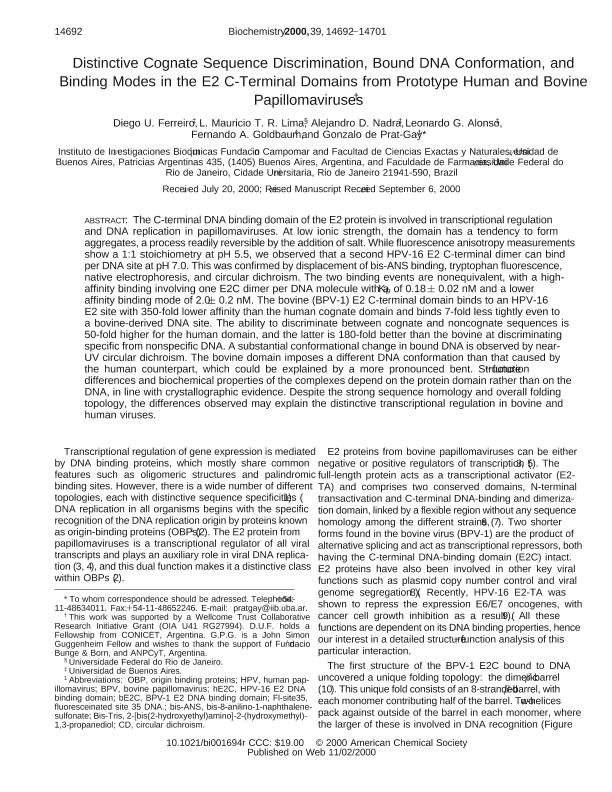Artículo
Distinctive Cognate Sequence Discrimination, Bound DNA Conformation, and Binding Modes in the E2 C-Terminal Domains from Prototype Human and Bovine Papillomaviruses
Ferreiro, Diego ; Lima, L. Mauricio T. R.; Nadra, Alejandro Daniel
; Lima, L. Mauricio T. R.; Nadra, Alejandro Daniel ; Alonso, Leonardo Gabriel
; Alonso, Leonardo Gabriel ; Goldbaum, Fernando Alberto
; Goldbaum, Fernando Alberto ; de Prat Gay, Gonzalo
; de Prat Gay, Gonzalo
 ; Lima, L. Mauricio T. R.; Nadra, Alejandro Daniel
; Lima, L. Mauricio T. R.; Nadra, Alejandro Daniel ; Alonso, Leonardo Gabriel
; Alonso, Leonardo Gabriel ; Goldbaum, Fernando Alberto
; Goldbaum, Fernando Alberto ; de Prat Gay, Gonzalo
; de Prat Gay, Gonzalo
Fecha de publicación:
11/2000
Editorial:
American Chemical Society
Revista:
Biochemistry
ISSN:
0006-2960
e-ISSN:
1520-4995
Idioma:
Inglés
Tipo de recurso:
Artículo publicado
Resumen
The C-terminal DNA binding domain of the E2 protein is involved in transcriptional regulation and DNA replication in papillomaviruses. At low ionic strength, the domain has a tendency to form aggregates, a process readily reversible by the addition of salt. While fluorescence anisotropy measurements show a 1:1 stoichiometry at pH 5.5, we observed that a second HPV-16 E2 C-terminal dimer can bind per DNA site at pH 7.0. This was confirmed by displacement of bis-ANS binding, tryptophan fluorescence, native electrophoresis, and circular dichroism. The two binding events are nonequivalent, with a high-affinity binding involving one E2C dimer per DNA molecule with a K(D) of 0.18 +/- 0.02 nM and a lower affinity binding mode of 2.0 +/- 0.2 nM. The bovine (BPV-1) E2 C-terminal domain binds to an HPV-16 E2 site with 350-fold lower affinity than the human cognate domain and binds 7-fold less tightly even to a bovine-derived DNA site. The ability to discriminate between cognate and noncognate sequences is 50-fold higher for the human domain, and the latter is 180-fold better than the bovine at discriminating specific from nonspecific DNA. A substantial conformational change in bound DNA is observed by near-UV circular dichroism. The bovine domain imposes a different DNA conformation than that caused by the human counterpart, which could be explained by a more pronounced bent. Structure-function differences and biochemical properties of the complexes depend on the protein domain rather than on the DNA, in line with crystallographic evidence. Despite the strong sequence homology and overall folding topology, the differences observed may explain the distinctive transcriptional regulation in bovine and human viruses.
Palabras clave:
Papillomavirus
Archivos asociados
Licencia
Identificadores
Colecciones
Articulos(IIBBA)
Articulos de INST.DE INVEST.BIOQUIMICAS DE BS.AS(I)
Articulos de INST.DE INVEST.BIOQUIMICAS DE BS.AS(I)
Citación
Ferreiro, Diego; Lima, L. Mauricio T. R.; Nadra, Alejandro Daniel; Alonso, Leonardo Gabriel; Goldbaum, Fernando Alberto; et al.; Distinctive Cognate Sequence Discrimination, Bound DNA Conformation, and Binding Modes in the E2 C-Terminal Domains from Prototype Human and Bovine Papillomaviruses; American Chemical Society; Biochemistry; 39; 47; 11-2000; 14692-14701
Compartir
Altmétricas



